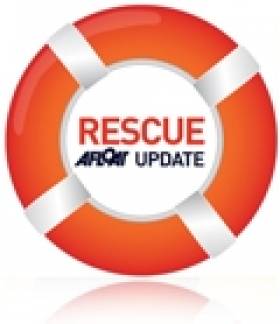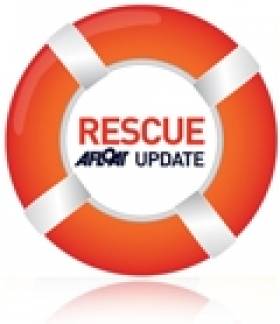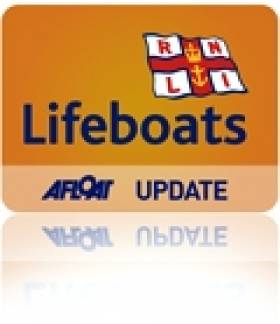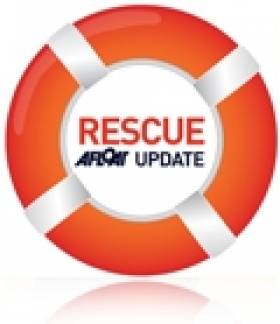Displaying items by tag: Search and Rescue
Air Corps Patrol Assists in Rescue of Injured Fisherman
#RESCUE - The Irish Times reports that an Air Corps maritime patrol aircraft joined a search and rescue mission to evacuate a fisherman off the West Cork coast today.
The Casa CN 235 - one of two operated by the Air Corps - diverted from its daily patrol to provide a communications relay in the operation to rescue an injured crewman from a Spanish fishing boat some 100 miles south of of Castletownbere.
The fisherman was airlifted by an Irish Coast Guard helicopter which at last report was taking him to medical attention in Cork.
New SAR Exhibition at Cornwall Maritime Museum
#SAR – Force 10 storm, zero visibility, 40ft waves, someone needs rescuing. It's time to go to work. Search and Rescue, the new blockbuster exhibition from National Maritime Museum Cornwall invites you to enter the world of the rescue services where ordinary people lead extraordinary lives, risking their life to save yours.
Opening on 16 March, the exhibition takes you on an interactive, stimulating and emotive journey into the role of the maritime rescue services, celebrating the work of the RNLI, Royal Navy, Royal Air Force, HM Coastguard and other organisations.
Objects of epic proportions include a 70ft Sea King helicopter, kindly loaned by the MOD, one of the Museum's most ambitious installations. Uniquely painted in the colours of both the Royal Navy and RAF Search and Rescue (SAR) services (red and grey one side and yellow on the other) it offers you the rare opportunity to climb inside, without having to be rescued. Dress as a pilot, listen to accounts from the crew and from those that have been rescued, explore their lifesaving equipment and discover the world of the Royal Navy and RAF SAR teams.
Revisiting rescues from the past, some well-known and some untold, this exhibition showcases the individuals whose job it is to head into the eye of the storm, when most of us would flee. The exhibition traces the evolution of rescue equipment from the early days of Henry Trengrouse's rocket line to the cutting edge equipment of today and shows that although the equipment might have changed, the determination and grit of rescue men and women to save lives has never changed.
At the heart of the exhibition is an interactive coastguard operations room. Put yourself in the coastguard hot seat, make the life or death decision to bring in the right service for the rescue and begin your journey through the incredible work and lives of the coastguard rescue, air and sea rescue teams.
Get up close to one of the Royal National Lifeboat Institution (RNLI) Atlantic 75 inshore lifeboats and see a fascinating assembly of the charity's collection boxes spanning 150 years. Take to the beach and become a virtual lifeguard, climb aboard a quad bike and take action to make sure the swimmers and surfers are between the right flags. See real seaside rescues and listen to accounts from volunteer crewmen and women.
Ben Lumby, Exhibitions Manager of National Maritime Museum Cornwall, says: "This is our biggest and most ambitious exhibition to date but more importantly it is the first time anyone has celebrated the maritime rescue services in this way."
"Working with these incredible teams has been a true privilege; they have kindly allowed us to see inside their world and shown us they're real people doing an amazing job. They belong to different organisations and charities but work as a team and you can be safe in the knowledge that if things do go wrong at sea, there's a service that will be there for you."
The new Search & Rescue exhibition at National Maritime Museum Cornwall opens on 16 March. Honouring the work of the heroic men and women who risk their lives at sea and around our coast, it invites you to be part of their world and shares their lives with you.
Throughout the two year life of the exhibition there will be a number of events including air sea rescue demonstrations, 'meet the crew' days and opportunities to climb aboard an RNLI all-weather lifeboat. To keep up to date with what's on when, visit www.nmmc.co.uk
New Helicopter for Irish Coast Guard is Completed
#COASTGUARD - Sikorsky has completed production of a new S-92 helicopter for the Irish Coast Guard under the rescue service's €500 million deal with CHC Ireland.
The US-based helicopter firm and CHC formalised the purchase on Wednesday (21 December) with Irish Coast Guard director Chris Reynolds during a hand-over ceremony at the S-92 commercial helicopter assembly facility in Coatesville, Pennsylvania.
Equipped for dedicated search and rescue (SAR) operations, the helicopter will provide coverage for deep Atlantic Ocean missions, service Ireland's offshore islands and provide rescue cover on the west coast from Cork to Galway.
The new aircraft will be based at Shannon and will replace the current coastguard SAR helicopter, a Sikorsky S-61, which has given 20 years of unbroken service.
According to Sikorsky, the S-92 is equipped with advanced systems and hardware, including an automated flight control system that enables the pilot to fly pre-programmed search patterns and perform delicate hover manoeuvres; a wireless intercom allowing a rescue swimmer to communicate with the crew; radio transceivers to communicate with ships and rescue services; a weather radar and infrared sensor; and a digital video system to record rescues.
Reynolds said the new helicopter - which joins four second-hand machines on a 10-year lease - represents a stepped improvement in Ireland's ability to care for and service its seagoing, coastal and island communities.
"I am very happy that the Coast Guard will operate what I consider to be the leading SAR helicopter in the world," he added.
As reported earlier this year on Afloat.ie, the new chopper is part of a deal that raised questions from a Fine Gael TD over allegations that a competing tender did not have a "good reputation".
Fergus O'Dowd questioning the contract with CHC Ireland after receiving documents in which Chris Reynolds said the Air Corps – whose helicopters are supplied by AgustaWestland - were uneqipped for the role and that no cost saving would be made if they took on the service.
Man in Serious Condition After Falling Overboard Off Clare
Breaking News reports that the individual was seen experiencing difficulty in the sea north of Kilkee, close to Donegal Point.
The Irish Coast Guard and Kilkee Marine Rescue Service immediately mounted a rescue operation, and the man was removed from the water by rescue helicopter to Limerick's Mid Western Regional Hospital.
The man is believed to be in a serious condition.
Body on Newry Beach Could Be That of Missing Kayaker
As previously reported on Afloat.ie, area man Mark McGowan, 37, was last seen kayaking in the lough at 7.30pm on Monday 10 October.
His blue kayak was spotted by the Irish Coast Guard on 11 October at Killowen Point, on the north side of the lough.
A cross-border search and rescue operation was immediately launched but progress was hampered due to bad weather.
The Belfast Telegraph reports that a body was discovered on Cranfield Beach near Newry by a member of the public yesterday morning. Formal identification of the body has not yet taken place.
At the time of his disappearance, McGowan was described as 5'7" tall, medium build, with a clean shaven, tanned complexion and short bleached blonde hair. He was last seen wearing a red jacket, blue jeans and white trainers.
Body of Garda Drowned in Flash Flood Recovered
The body of an off-duty garda who was swept away by floodwater in Co Wicklow during Monday's torrential rain has been recovered.
The Irish Times reports that 25-year-old Garda Ciaran Jones was pulled into the River Liffey at the Ballysmuttan Bridge around 7pm on Monday while warning motorists not to cross the bridge.
A search and rescue operation was immediately launched involving the Irish Coast Guard, the Garda helicopter and mountain and river rescue teams, according to the Irish Examiner.
His body was eventually found at 9am yesterday morning some 4km downstream of the incident.
Supt Eamon Keogh of Blessington Garda Station noted that Garda Jones had been crossing the bridge to warn an oncoming car when he was swept into the swollen river by a sudden surge of water.
Taoiseach Enda Kenny led tributes to the young garda as well as a woman who died at her home in Dublin during the flooding that caused chaos across the east of Ireland on Monday evening, with several inland waterways bursting their banks.
Clyde Campaigners Hope for U-Turn on Coastguard Closure Proposal
Scottish campaigners have made their final pleas to save the Clyde coastguard station from closure, the Greenock Telegraph reports.
Under the UK government's plans to streamline Britain's coastguard network, the control centre at Greenock is set to be scrapped with the loss of 31 jobs, while River Clyde rescues will in future be handled from Northern Ireland.
As previously reported on Afloat.ie, Northern Ireland's only dedicated search and rescue centre on Belfast Lough was saved from the chop following a review of plans to reform the Maritime and Coastguard Agency's nationwide network.
A consultation on the propose closure concluded yesterday, and locals join staff, union leaders and politicians in hoping they can persuade the government to give Clyde a reprieve.
"Local knowledge and understanding are vital when dealing with emergency situations." said local MSP Stuart McMillan.
"To remove a committed and fully functioning coastguard service with expert local knowledge would leave a void that could not be filled by an over stretched centre in Belfast."
The Greenock Telegraph has more on the story HERE (registration required).
Planet Jupiter Mistaken for Distress Flare
A extensive rescue search in northeast England was called off on Monday when it was found that the planet Jupiter had been mistaken for a distress flare.
BBC News reports that Tymemouth RNLI lifeboat and an RAF rescue helicopter had been dispatched to search for a possible vessel in distress after a call from a member of the public on Monday evening.
But on establishing further details from the informant "it became apparent that the flares were in fact the planet Jupiter which is very low in the sky at this time of year", said Tynemouth RNLI's Adrian Don.
The RNLI stresses that the false alarm was made with the "best intentions" and urges anyone who thinks they have spotted a vessel in distress to contact emergency services.
Lost Irish Fishermen Found Safe and Sound Off Minehead
FOUR Irish fishermen reported missing on Sunday have been found in good spirits off the coast of Minehead in Somerset.
This Is The West Country reports that the four men had left Helvick harbour in Co Waterford early on Sunday on a fishing trip but got lost shortly thereafter.
After contacting the coastguard with their concerns, the Helvick Head RNLI lifeboat was dispatched to Minehead, where the lost boat had been found by another fishing vessel, Faoilean Ban.
The lost fishermen subseqently followed the Faoilean Ban back to port at Helvick.
Tourist Saved By Light of Mobile Phone
A tourist was rescued from some of Ireland's tallest sea cliffs in Co Donegal yesterday when a coastguard team spotted the light from her mobile phone.
The Irish Independent reports that the 24-year-old German woman had gone missing in an area known as the Pilgrim's Path, near Slieve League, on Saturday evening.
A full-scale search was mounted by the Donegal Mountain Rescue Service after she failed to return to Bunglass as scheduled.
The woman was eventually located by the Killybegs unit of the Irish Coast Guard in the early hours of yesterday morning. She was unharmed apart from a slight ankle injury, and was said to be "very wet, cold and disorientated".
Brian Murray of Donegal Mountain Rescue said: "There was no mobile phone signal in the area and she was lucky that the coastguard service managed to see the light from her phone."
The woman is the second tourist to go missing in the same part of Donegal in recent weeks.






































































